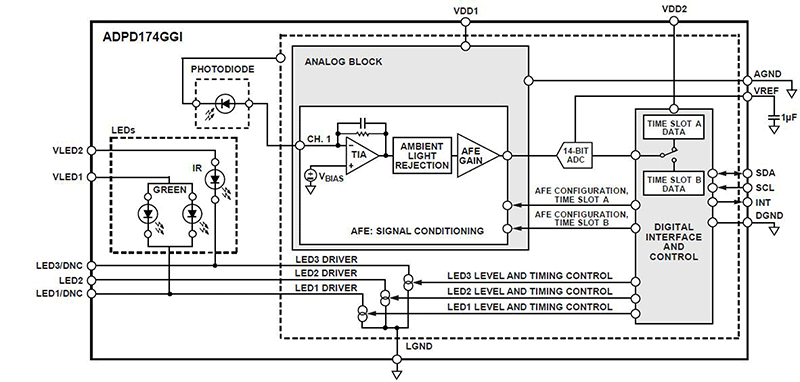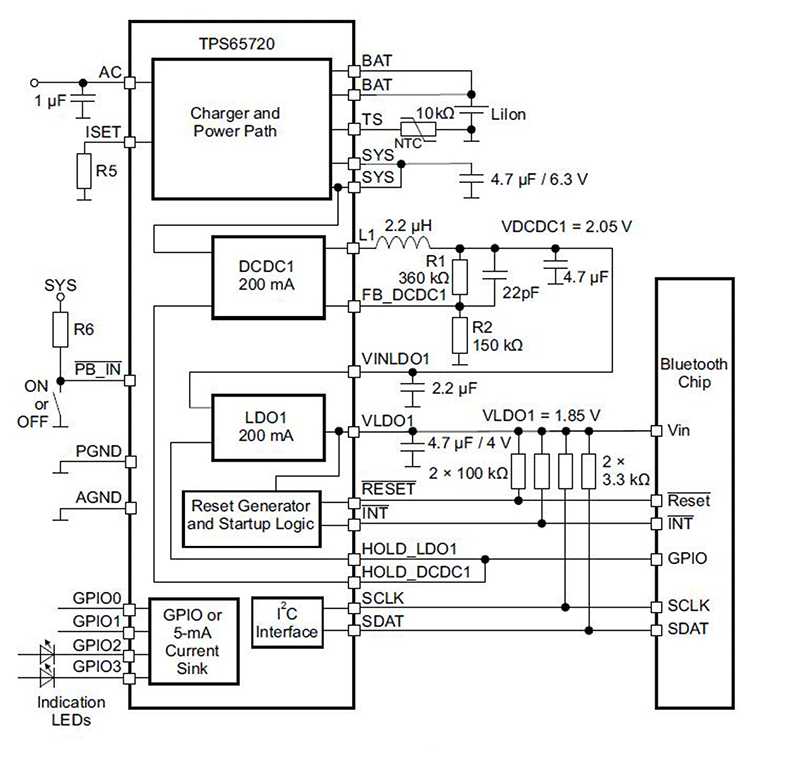By Mark Patrick, Mouser Electronics
 In common with many portable devices these days, portable medical devices present conflicting requirements to designers, giving them something of a challenge. The devices must be small and light enough to be worn by a patient 24/7, which will require the use of a relatively small battery – however, many monitoring devices also need to operate in “always on” mode. Furthermore, these devices must be robust to withstand the rigors of everyday use and have sufficient performance to accomplish (sometimes complex) tasks well. As these devices use highly sensitive sensors to pick up small signals from the human body, power architectures must be developed with care so as not to degrade the signals being measured.
In common with many portable devices these days, portable medical devices present conflicting requirements to designers, giving them something of a challenge. The devices must be small and light enough to be worn by a patient 24/7, which will require the use of a relatively small battery – however, many monitoring devices also need to operate in “always on” mode. Furthermore, these devices must be robust to withstand the rigors of everyday use and have sufficient performance to accomplish (sometimes complex) tasks well. As these devices use highly sensitive sensors to pick up small signals from the human body, power architectures must be developed with care so as not to degrade the signals being measured.
The availability of mobile networks and mobile devices that act as “gateways” to the Internet has been a significant driver in the growth of wearable devices, transforming them from standalone products into highly connected and valuable devices. The first usage of so-called “fitbit” monitors was in the sports market, both professional and hobbyist. However, as more capability is added, these are becoming valuable devices in the medical world as well.
The inclusion of sensors based on micro electro-mechanical systems (MEMS) such as accelerometers and gyroscopes has delivered far more functionality to these wearable medical devices. As devices evolve, other sensors have also been added to measure parameters such as skin conductance and pulse variability. However, these sensors are highly sensitive and signal-to-noise ratio (SNR) is an important issue here, which impacts other aspects of the design – in particular, the power system, which can be a source of disruptive noise.
Optical Measurement Requires a Low-Noise Environment
In order to use optical sensors effectively, design engineers seek to detect the smallest signals by ensuring that the SNR is optimized. However, as all wearable medical devices are battery powered, they require some form of voltage conversion, and modern voltage converters have a number of attributes that can degrade SNR including ripple current/voltage and extended settling times.
One of the most fundamental things to a human being, and consequently one of the most often-measured parameters, is heart rate. The most simple measurement is beats per minute, but through measuring other parameters, much more can be deduced about the operation of the heart. For example, measuring changes in blood volume through the distension of arteries and arterioles in the subcutaneous tissue via an optical method known as photo-plethysmography (PPG) can be useful in determining oxygen saturation in the blood (SpO2).
The most common method of measuring SpO2 is to clip a sensor to the patient’s finger. In these devices, an LED in one side of the device generates a light beam that passes through the skin. Variations in this light transmission inside the finger are then measured by a light-sensitive photodiode on the other side of the device.
Using optical techniques for measuring heart rate gives designers a number of challenges as they seek to address issues such as ambient light effects, interference and movement of the sensor in relation to the patient’s finger.
Given the popularity of this type of measurement, manufacturers are developing solutions such as Analog Devices’ ADPD174. This is an optical subsystem specifically designed for this application, which comprises a highly efficient photometric front end, three LEDs and a high-performance photodiode. Through this integration, many of the issues are reduced.
Using a bracelet for PPG techniques is another way of reducing the effects of ambient light and, along with other techniques including narrowband optical filters, modulation of the optical signal, automatic gain control (AGC) of the electrical signal, filtering of the signal and a low-noise power supply, accurate measurement is possible.

As these wearable devices are battery powered, power efficiency is a very important topic. In optical systems the LEDs require a different voltage to that obtained from the Li-ion batteries, so voltage conversion is required. Low dropout (LDO) regulators are generally relatively inefficient, so innovative switching techniques are used. Buck-boost topologies are popular, as they require relatively little board space and are generally quite efficient. In particular, the single-inductor multiple-output (SIMO) buck-boost topology is often used due to its low component count. Whichever topology is chosen, ripple must be well controlled so that important heart rate measurements are not interfered with.
Power Management ICs (PMICs) Deliver Better Efficiency
All personal and remote monitoring products share a need for accuracy, small size and long battery life. While operational power consumption is important, most of these devices spend the greatest proportion of their time in standby mode while not measuring or transferring data, so standby power consumption becomes most important. Many modern PMICs are able to generate higher voltages from a battery input and can manage standby power effectively.
One popular PMIC is Maxim Integrated’s MAX20345, which is ideally suited to products that require 24/7 operation. It includes a buck-boost converter to generate the higher voltages required by peripherals such as sensing devices. Intended for use in sensitive systems, the PMIC generates minimal noise, ensuring the most accurate measurement possible.
Texas Instruments has integrated a high-efficiency step-down converter and a battery charger into its TPS6572x series of PMICs. These devices permit small external components (inductors/capacitors) to be used, thereby reducing the overall size of the solution. The TPS65720 is rated for 200mA of output current, while other devices in the series (TPS657201, TPS657202, TPS65721) have a 400mA rating. All four devices include a 200mA LDOregulator that can accommodate voltages in the range of 1.8V to 5.6V, allowing them to be powered by a step-down converter or directly from the system voltage.


Active-Semi’s ACT81460 offers a fully-featured power management solution that protects battery life due to extremely low standby current consumption. By utilizing the entire battery capacity up to 2.7V, the inbuilt (and highly efficient) buck-boost converter is capable of powering many different types of sensing peripherals, including optical heart-rate sensors. The regulators and inbuilt battery charger have ultra-low quiescent currents that deliver high efficiency, even with the lightest loads – including those associated with wearable medical technology.
Personal medical care will rely heavily on portable devices that are convenient for patients and reduce pressure on medical facilities. These devices will collect data related to vital signs and activity and transmit this information securely to medical professionals. However, to be useful these devices must be highly portable, highly accurate, reliable, simple to use and have a long working time between battery changes/recharging. Modern PMICs can manage the power budget effectively in these devices while not impacting measurement accuracy, enabling these devices to deliver their intended benefits.






